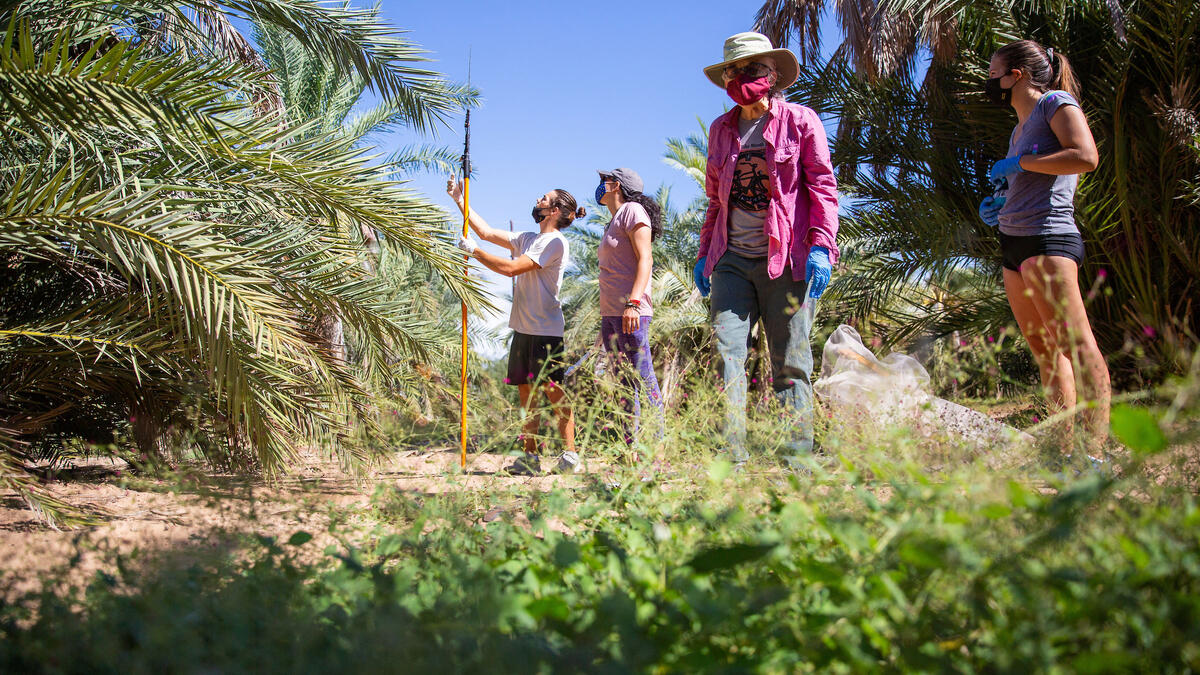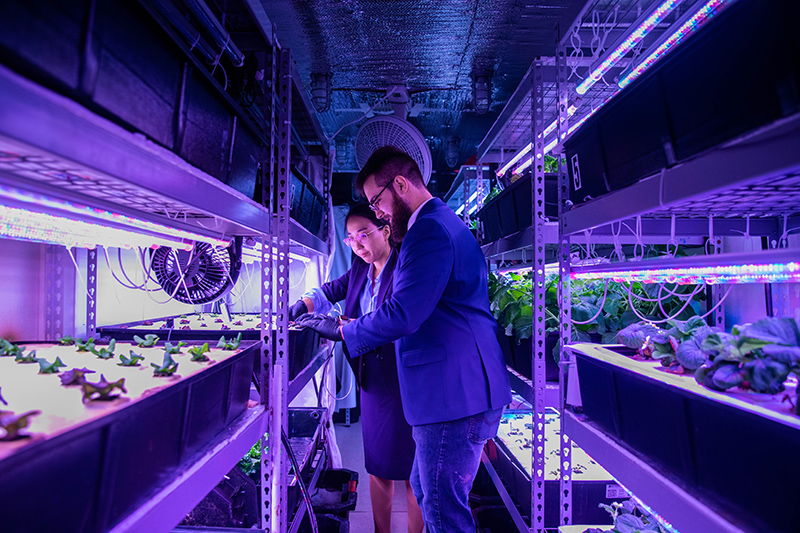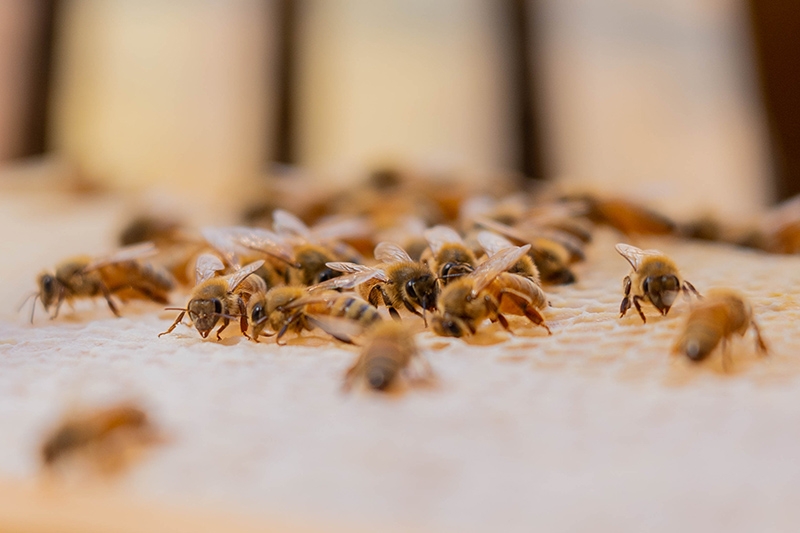Orderly rows of lettuce, flowers and vegetables in raised planter beds flourish alongside pecan and citrus trees at the Garden Commons on Arizona State University's Polytechnic campus.
Here, students toil in the desert sun, planting bok choy, cilantro and jalapeños, as they the learn lessons from the earth on everything from organic and regenerative farming to seed selection and germination to composting and beneficial insects.
The garden is abuzz with nature’s hard-working pollinators from one of the nation’s largest bee research facilities in the United States, tucked away in a dirt lot on the southern edge of the Polytechnic campus. Here, Cahit Ozturk, a research technologist and associate researcher at ASU’s Bee Lab Annex, dons a beekeeping suit to show visitors how up to 2,000 pounds of honey is harvested from the more than 50 honeybee colonies at the lab each year.
Nearby is a desert oasis of more than 40 varieties of rare date palm trees with lush fronds, textured trunks and luscious fruit that was a common sweet treat 100 years ago. ASU’s date palm “germplasm” is a living genetic resource maintained for plant breeding and research. Deborah Thirkhill, program coordinator at ASU Facilities Development and Management Grounds Services, organizes a harvest each year.
ASU’s entire Tempe campus is a designated arboretum meant to be an oasis for plants around the world, including citrus, olive, pecan, sapote, apple, peach, quince and many other harvestable trees and shrubs. Here, 260 Seville sour orange trees produce six to eight tons of fruit each year, harvested January through March.
On both the Tempe and Downtown Phoenix campuses, Engrained Café offers a seasonal menu featuring locally grown and harvested food in a full-service, dine-in restaurant. Its assortment of sustainable food includes organic produce, fair-trade coffee, locally grass-fed beef, cage-free eggs and all-natural chicken.
Nestled among this cornucopia of fresh fruits and vegetables grown on ASU’s campuses are innovators shaping the sustainable future of food.
Advocating for organic farming

Kathleen Merrigan
A long-time advocate for organic farming, Kathleen Merrigan literally wrote the law that established national standards for organic food. As former deputy secretary and COO of the United States Department of Agriculture, she led efforts to support local food systems from 2009 to 2013.
Now the executive director of the Swette Center for Sustainable Food Systems at ASU, she has co-authored a new report with the Natural Resources Defense Council and Californians for Pesticide Reform to help guide U.S. policymakers on the benefits and value of organic agriculture practices in preparation for the next version of the Farm Bill. The most recent version of this federal legislation was enacted in 2018 and is set to expire in 2023.
“Every Farm Bill is hugely important. It controls about 70% of what the USDA does and puts out billions and billions of dollars,” Merrigan says. “One of the things I’ve been doing at the Swette Center for Sustainable Food Systems is raising the flag that the government has underinvested in organic agriculture. Across the USDA’s 17 agencies and hundreds of programs, probably less than 1% of the money going out the door is spent on organic. We’d like to make the case it should be 6%. It’s such a modest ask. It represents how much food is currently purchased by Americans that is organic. What a world of difference it would make.
“As we face the grim news that we’re not doing enough to combat climate change, I think organic is a great answer to a lot of the problems that we face, not only in the U.S., but globally."
Her new report, “Grow Organic: The Climate, Health and Economic Case for Expanding Organic Agriculture,” details the potential of agriculture in addressing climate change, health crises and economic struggle. Topics discussed in the report include organic agriculture’s ability to reduce greenhouse gas emissions, protect human health and support economic resilience.
For example, organic farming eliminates the greenhouse gas nitrous oxide resulting from the use of synthetic fertilizers. And organic farming is a smart choice because it produces higher crop yields in the face of climate change.
The rise of the vertical farm
A glimpse of the future of farming can be seen inside ASU’s vertical farm on a tucked-away corner of the Polytechnic campus. Yujin Park, an assistant professor in the College of Integrative Sciences and Arts, watches over racks of strawberries and lettuce in white shipping containers growing under exotic colorful lighting.
The Economist listed vertical farming as one of the top 22 emerging technologies to watch in 2022. Park, whose research focuses on horticultural crop physiology and controlled environment agriculture, says the indoor farming method could be the wave of the future in today’s era of climate change.
“Vertical farming could be a real game changer if water becomes really scarce,” she says. “In general, in comparison to field crop production, vertical farms can save 90 to 95 percent of water for growing crops.”
Vertical farming provides reliable year-round crop production unaffected by adverse weather conditions and uses no agrochemicals or pesticides. As countries such as Britain, Denmark and the United States establish vertical farms in urban areas, they provide the ultimate local food.
The College of Integrative Sciences and Arts began offering a certificate program in vertical farming this fall semester. Classes are taught by Park and her colleague, Zhihao Chen, an instructor teaching chemistry and controlled environment agriculture within ClSA and co-founder of Homer Farms Inc., a cleantech startup establishing a circular economy in food waste and food production.
READ MORE: A look inside ASU's vertical farm
Yujin Park and fellow researcher Niklas McClintic examine the health of plants growing in the vertical garden research space on the Polytechnic campus. Photo by Deanna Dent/ASU
Creating a buzz in bee research
ASU’s Bee Lab Annex is a place where scientists delve into many aspects of honeybee research: their social behavior, learning and memory, neurobiology, aging, ecology, evolution and more. Students and community members can even take basic hobby beekeeping through advanced beekeeping courses.
As honeybees and other pollinator populations decline worldwide, the reasons remain controversial. Although fungicides have been deemed safe for honeybees in laboratory tests, ASU researcher Adrian Fisher, a postdoc in the School of Life Sciences, has discovered that field testing paints a different picture. His research reveals how exposure to fungicide creates serious health outcomes for honeybees, such as reduced protein digestion, reduced learning and memory capabilities, and reduced life span.
“In all, these findings point to the role that fungicides may play in ongoing pollinator declines and to the inadequacy of current toxicity testing standards used to approve pesticides for application,” Fisher says.
Researcher Nicole DesJardins is a doctoral student working with Brian Smith, a behavioral neuroscientist whose research focuses on learning and memory systems in both insects and mammals. In her research, DesJardins examines the effects of agricultural pesticides on honeybee behavior.
“Specifically, I have found that fungicides have a couple of negative effects on honeybee behavior. They interfere with their ability to learn about new things, such as the scent of flowers associated with food. And they can cause bees to become lost while out foraging, so they can't find their way back to the hive,” she says. “The implication is that fungicides are sprayed on a number of bee-pollinated crops, so bees could potentially get exposed to them and experience these negative behavioral effects.”
READ MORE: The sweet side of bee research
Social and hardworking insects, honeybees play an important role as crop pollinators. In fact, bee pollination accounts for about $15 billion in added crop value, according to the U.S. Food and Drug Administration. Photo by Samantha Chow/ASU
Fighting food insecurity
A surprising number of college students struggle to meet basic needs, such as stable housing or having enough food to eat. In fact, nearly 40% of college students at two-or-four-year schools have experienced food insecurity in the last 30 days, according to an annual survey conducted by Temple University’s Hope Center for College, Community and Justice.
Filling an important need, a weekly seasonal farm stand on the Polytechnic campus offers fresh produce to students at no cost.
“All students need to do is show their ID, and they’re allowed to pick from three to five fresh different fruits and vegetables,” says Susan Norton, ASU’s University Sustainability Practices assistant director. “During the cool season, we tend to have kale, lettuce, beets, carrots and peas. In our warm season, we have tomatoes, eggplant, cucumber, zucchini and basil.”
All additional produce is donated to the Pitchfork Pantry, a campus food pantry that receives, stores and distributes food to ASU students; House of Refuge, which provides housing and wrap-around support programs to families experiencing homelessness; and the AZCEND food bank in Chandler.
Over the last three years, nearly 2,000 pounds of fresh fruits and vegetables — nearly 5,000 servings — have been donated through the farm stand to 525 people in need, both at ASU and in the community.
The Swette Center for Sustainable Food Systems is a unit of the Global Institute of Sustainability and Innovation.
Top photo: Deborah Thirkhill (center), program coordinator at ASU Facilities Development and Management Services, organizes a date harvest on the ASU Polytechnic campus each year. Photo by Deanna Dent/ASU
More Science and technology

Applied Materials invests in ASU to advance technology for a brighter future
For nearly 60 years, global giant Applied Materials has been hard at work engineering technology that continues to change how microchips are made.Their products power everything from flat-panel…

Meet ASU engineering students who are improving health care, computing and more
Furthering knowledge of water resource management, increasing the efficiency of manufacturing point-of-care health diagnostic tools and exploring new uses for emerging computer memory are just some…

Turning up the light: Plants, semiconductors and fuel production
What can plants and semiconductors teach us about fuel production?ASU's Gary Moore hopes to find out.With the aim of learning how to create viable alternatives to fossil-based fuels, Moore — an…




